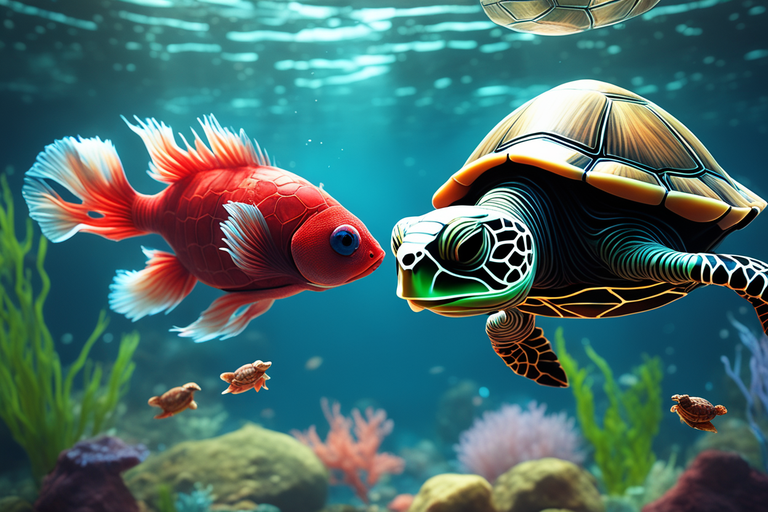You’re curious, can betta fish live with turtles?
It’s a tricky question needing a detailed look at both species’ habits, habitats, and needs.
You’ll find insights on their co-habitation, learn about necessary precautions, and explore real-life examples.
You’re not alone in this journey, and with the right knowledge, you’ll make the best decision for your aquatic pets.
It’s not a simple yes or no, but let’s dive in and find out together.
Understanding Betta Fish: Habits and Habitats

You’ll often find that understanding the habits and habitats of Betta fish is crucial to successfully keeping them with other species, such as turtles. Betta fish are solitary creatures by nature, and they prefer a quiet, serene, and warm aquatic environment. This understanding is essential, particularly when considering Betta breeding techniques. You need to provide sufficient space for them to establish territories, and a separate breeding tank is often required.
Betta disease prevention is another aspect that requires your attention. Betta fish are prone to various diseases like fin rot and fungal infections. To prevent these, you must maintain a clean tank, ensure a balanced diet, and avoid overcrowding. Regular water changes, proper filtration, and monitoring of water parameters are key in preventing diseases.
Understanding these aspects can help you create a compatible environment if you’re considering keeping Betta fish with turtles. Turtles are known to be playful and can be slightly aggressive, which might stress Betta fish. Thus, a thorough understanding of Betta fish’s habits, habitats, breeding, and disease prevention techniques can guide you in making an informed decision and ensuring the well-being of your aquatic pets.
Characteristics and Living Conditions of Turtles
In your quest to understand whether betta fish can live with turtles, it’s vital to grasp the inherent characteristics and unique living conditions of turtles. Turtles are reptiles, known for their hard shells that protect them from predators. They are aquatic or semi-aquatic creatures, requiring both land and water in their habitat.
Turtle Diet and Shell Maintenance play a significant role in their health and overall well-being. Turtles are omnivores by nature. Their diet includes a variety of foods like fruits, vegetables, insects, and even small fish. This diverse diet ensures they receive all necessary nutrients for shell and body growth.
Shell maintenance is equally critical. Regular exposure to UV light helps synthesize Vitamin D3, crucial for calcium absorption and consequently, healthy shell growth.
Here’s a quick overview:
| Turtle Diet | Shell Maintenance |
|---|---|
| Omnivorous Diet: Fruits, vegetables, insects, small fish | Regular exposure to UV light |
| Provides necessary nutrients for shell and body growth | Helps synthesize Vitamin D3 |
| Ensures overall health and well-being | Crucial for calcium absorption and healthy shell growth |
Understanding these aspects is paramount to creating a compatible environment if you plan on housing betta fish and turtles together.
The Possibility of Co-habitation: Betta Fish and Turtles
While you’re considering this possibility, it’s important to understand that the co-habitation of betta fish and turtles presents unique challenges and potential risks, but with proper care and monitoring, it may be achievable.
Betta Turtle Compatibility isn’t a concept that naturally occurs in the wild, so you’ll need to create an environment that caters to both species’ needs.
First, you must address Natural Predation Concerns. Turtles are omnivores and may view smaller betta fish as prey. To mitigate this risk, it’s recommended to introduce the betta when the turtle is young and less likely to exhibit aggressive behavior. Additionally, providing the turtle with ample food can reduce its predatory instincts towards your betta.
Secondly, differing habitat requirements pose a challenge. While bettas thrive in warm water, turtles require a diverse environment that includes both water and dry land. You’ll need a tank setup that accommodates these needs without compromising the health of either species.
Lastly, consider the stress factor. Both species can become stressed in shared environments, potentially leading to poor health. Regular monitoring and adjustments are crucial to ensure both your betta fish and turtle remain healthy and stress-free.
With thorough planning and constant vigilance, co-habitation could be a possibility.
Precautions to Take When Housing Betta Fish With Turtles
Before you decide to house betta fish with turtles, it’s crucial to take specific precautions and understand the potential challenges this unique pairing presents.
One of the main concerns is disease prevention measures. Both species can carry different kinds of diseases, some of which could be fatal to the other. It’s essential to regularly check your pets for any signs of illness and to maintain a clean habitat.
Tank size considerations also play a significant role in the success of this cohabitation. Turtles require a larger area to swim and bask, while bettas need space to move around but also places to hide for their safety. A small tank could lead to territorial disputes, stress, and potential harm for the betta fish. Ideally, the tank should be large enough to accommodate the turtle’s size, with a separate, secure area for the betta.
Moreover, the water temperature and diet needs differ for both species. You’ll need to ensure a balanced diet and a suitable temperature for both. It’s not an easy task, but with careful preparation and ongoing attentiveness, you can create a harmonious living environment for your betta fish and turtle.
Case Studies: Successful and Unsuccessful Co-Habitations
You’ll find that understanding through real-life case studies can offer valuable insights into the successes and failures of betta fish and turtle cohabitations.
- Case Study 1: A successful cohabitation involved a spacious tank with plenty of hiding spots for the betta. The turtle showed no signs of aggression, and the betta fish remained vibrant due to its reduced vulnerability.
- Case Study 2: Failure occurred in a small tank. Turtle aggression surfaced due to space constraints, leading to the betta’s demise. This case highlights the importance of a large, well-structured habitat.
- Case Study 3: Success was noted where the betta fish and turtle had been introduced at a young age. They grew accustomed to each other’s presence, leading to a peaceful cohabitation.
- Case Study 4: An unsuccessful cohabitation was reported where the turtle’s diet wasn’t strictly regulated. The turtle developed a taste for fish, making the betta vulnerable.
These cases show that betta fish and turtles can coexist, but certain conditions must be met. Factors such as tank size, hiding spots, introduction age, and strict diet regulation can determine the success or failure of their cohabitation.

